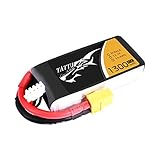10 Best 3s Lipo Battery of December 2025
List of Top Rated 3s Lipo Battery from thousands of customer reviews & feedback.
Updated On Dec 2025
1,825 Reviews Studied

- Tattu Professional LiPo Battery; Superior Japan and Korea Lithium Polymer raw materials
- Quickly Recharged, long cycle life (150 times minimum), up to 200Wh/kg energy density
- Parameter: Weight, 119g; Dimension(L*W*H), 72*36*23mm; Connector, XT60 Plug
- Applications: QAV250, QAV180/210, Vortex 285, Mini H, FLIP FPV 250S MINI, FLIP FPV FRAME, FLIP FPV 260H MINI, Emax Nighthawk 250, ZMR 250, HOVERSHIP MHQ2(270), ZUUL RACEHOUND 265/285, MOJO 280, VECTOR 250
- What you get: Tattu LiPo Battery Pack with XT60 Plug & Local after-sales service (located in Dublin, CA)
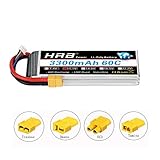
- Longer lifetime: 150 times minimum, Anode is made with 100% Co,Separator is used Korea imported material,aluminum laminate film is used Japan imported material,doubles your devices performance time.
- Specification:Material: Li-polymer; Battery voltage: 11.1V; Cell: 3S; Cell voltage: 3.6~4.2V; Capacity: 3300mAh; Discharge: 60C; Discharge plug: XT60(Compatible with Traxxas Plug, Tamiya Plug, Deans Plug & EC3 Plug.)
- Dimension: 5.31 x 1.65 x 0.83 inch/pc; Net weight: 9.31oz/pc, All HRB products sold by HRB POWER are comply with RoHS, CE standard.
- Package:1pcs HRB 11.1v 3300mah 60c xt60 lipo battery +4pcs different discharger plug (EC3/T/Traxxas/Tamiya)
- Application: Fit for Traxxas 1/10: Rustler VXL Stampede 2WD VXL Stampede 4x4 VXL Bandit VXL Funny Car
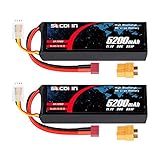
- 【Details】☛Material: Lithium polymer;Battery voltage: 11.1V ; Capacity: 5200mAh; Discharge:60C;Plug:Deans T,XT60; Configuration: 3S1P. 1P products with higher quality, more durable and battery life is longer.
- 【Dimensions】☛133*44*28.5mm /5.24*1.73*1.12inch(L*W*H)/pc,346g/12.2oz/pc
- 【Applicable equipment】☛Designed for rc toy products ,as long as the voltage, size and plug match, it is suitable.Such as RC Car, RC Buggy, RC Truck, RC Truggy ect. 1/8 and 1/10 rc car such as Losi, Traxxas Slash, HPI Strada XB 1/10 RTR Electric Buggy, Team Associated, Axial, Tamiya, Duratrax, Jammin, Redcat Racing, Exceed RC, ElectrixRC, Emaxx, Bandit, Rustler version etc.(Only if the voltage, dimension and the plug match, then it will fit).
- 【Function】☛Socokin 3S 60C discharge rate rc lipo battery 's high speed charging and excellent endurance power provide good Experience for your remote control equipment in activities.
- 【Wat you get】☛2 PVC soft case socokin 5200mAh 60C 11.1V RC Lipo battery,30 days money back ,worry-free 12-month warranty and our sincere service.If you have any question,please contact us.
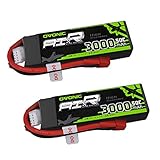
- 【Compatible for】- RC airplane, helicopter, car, truck, boat, drone, FPV, Skylark m4-fpv250, Mini Shredder 200, Indy250 plus mojo 280, Qav250, Vortex and Emax nighthawk 250 (Only if the voltage, dimension and the plug match, then it will fit).
- 【Professional and Reliable】 - Specially designed, manufactured for your high-quality RC devices. Ovonic always be strict of product quality
- 【High Capacity, More Powerful】 - Advanced Lipo battery with uniquely designed doubles your devices performance time and stronger power
- 【Specification】- Battery Dimensions: 105*32*28mm(Please compare the battery size with your battery slot ); Cells Number: 3; Voltage: 11.1V; Minimum Capacity: 3000mAh ; Discharge: 50C; Charge Plug: JST-XH-4P; Discharge plug: T Connector
- 【What you get】 - 2 Packs Ovonic LiPo Battery with Deans Plug
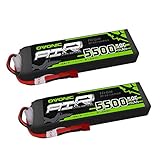
- 【Compatible for】- 1/8 & 1/10 RC car model such as Traxxas Slash, 1/10 E-Revo tsm, Monster Jam Replicas, HPI Strada XB 1/10 RTR Electric Buggy, Kyosho GP 4WD Racing Truck.
- 【Professional and Reliable】 - Specially designed, manufactured for your high-quality RC devices. Ovonic always be strict of product quality
- 【High Capacity, More Powerful】 - Advanced Lipo battery with uniquely designed doubles your devices performance time and stronger power
- 【Specification】- Discharge plug: Dean-style T connector. Dimensions: L*W*H:155*45*23mm ,Weight:376g
- 【What you get】 - 2 Packs Ovonic LiPo Battery with Deans Plug
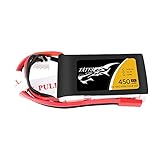
- All Tattu LiPos are packed with vibration-proof & fire-proof material and our luxury battery box ensuring you get your battery in perfect condition. An automatic procedure & Computer system battery cell matching process ensures the batteries stability and quality.
- Quickly Recharged, long cycle life (150 times minimum), up to 200Wh/kg energy density. Less Voltage sag during high rate discharge, giving more power under load.
- Parameter: Weight, 40.5g; Dimension(L*W*H), 55*30.5*16mm; Connector, JST-SYP-2P Plug
- Application: specially designed for your smal-size FPV, torrent110 Baby Hawk, E-flite Viking Model 12 280, Inverza 280, and Adagio 280
- The Tattu battery comes with 24 hours' friendly customer service. Please feel free to contact us if you have any questions.
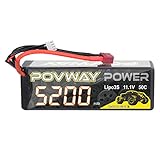
- 【SPECIFICATION】Material: Li-polymer; Voltage: 11.1V; Cell: 3S; Capacity: 5200mAh; Discharge: 50C; Discharge connector:Deans T plug. Dimension(L*W*H): 5.31x1.65x1.38inch(135x42x35mm).
- 【SAFETY &Quality GUARANTEE】:The lipo rc battery Built-in protection mechanism ensures safe charging and use.It comes with a balance lead protector, it can effectively prevent the plug from falling off.
- 【5200mAh BATTERY】The 5200mAh battery increase the runtime for you RC device.The 50c burst rate gives you enough power for acceleration. Long cycle life (150 times minimum),Up to 200Wh/kg energy density.
- 【WIDE COMPATIBLE】Useful for RC Car, RC Buggy, RC Truck, RC Truggy ect. dimension(L*W*H):5.31x1.65x1.38 inch(135x42x35 mm). Battery Weight:14.46 oz/410g . Please check the dimension,voltage, plug before you order it.It can works well in your RC devices if these three aspects are suitable.
- 【30 DAYS MONEY BACK】We offer 30 days money back and 12 month warranty.If you need any help ,please contact our email: [email protected]
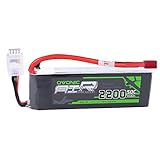
- Specification: Material: Lithium polymer; Battery voltage: 11.1V; Cell: 3S; Cell voltage: 3.7~4.2V; Capacity: 2200mAh; Discharge: 50C; Discharge plug: Dean-style T connector
- Dimension: 4.17*1.3*0.9inch (106*33*23MM); Net weight: 6.6oz/pc(179g)
- Application: P-51 RC plane, E flite Valiant, Parkzone E4F wildcat, Great Planes E-Cub, Eflite Pitts S1-S biplane, 3D aircraft,park flyer,RC crawlers,Align trex 450 (Only if the voltage, dimension and the plug match, then it will fit)
- What You Get: Ovonic 3s 11.1V 2200mAh 50C dean-style T connector lipo battery
- Voltage Note: Please check whether the battery surface is alright when you get it and whether the voltage is between 3.7~4.2V before using

- 【Zeee 3S battery 5200mAh specification】- Material: Lithium polymer; Battery voltage: 11.1V; Configuration:3S1P; Capacity: 5200mAh; Discharge: 50C; Connector: Deans and XT60 Plug.
- 【Dimensions】- Zeee 11.1V 50C 5200mAh rc lipo battery dimension is: 132*43*25mm/5.2*1.69*0.98 inch(L*W*H); Approx Weight(±15g): 343g /12.1oz.
- 【Powerful Functions】- Zeee 3S battery 5200mAh has a huge capacity for extended run times and a gigantic C rating so you'll have all the power you'll ever need.
- 【Application】- Zeee 3S 5200mah lipo battery suitable for RC helicopter, airplane, multirotor, Boat, Car, Truck, Traxxas models 1/10 scale vehicles or larger, Traxxas RC Cars, Slash VXL, Slash 4x4 VXL, E-Maxx Brushless, E-Revo Brushless and Spartan models(Only if the voltage, dimension and the plug match, then it will fit)
- 【What You Get】- 1 Pack of Zeee 11.1V 50C 5200mAh lipo battery with Deans T and XT60 plug. After-sales Service: Every Zeee Product has 30 Days Money Back Guarantee & 12 Months Warranty. Please contact us immediately if you have any problems, we will reply you within 24 hours.
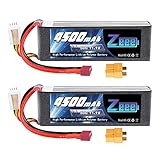
- 【Specification】-Material: Lithium polymer; Battery voltage: 11.1V; Capacity: 4500mAh; Discharge rate: 50C; Configuration: 3S1P; Plug: Deans T/ XT60 connector.
- 【Dimensions】- Zeee 3S 4500mAh RC Lipo battery dimension is(±2mm): 133*45*23mm/5.24*1.77*0.9inch(L*W*H); Approx Weight(±10g): 293g/10.34oz.
- 【Application】- Zeee 11.1V 4500mAh lipo battery applied for RC Evader BX Car, RC Truck, RC Truggy RC Airplane UAV Drone FPV etc. (Only if the voltage, dimension and the plug match, then it will fit).
- 【High Performance】- Zeee 3S 4500mAh lipo battery with 50C discharge rate offers you very high power and very long run time for your RC models.
- 【What You Get】- 2 Pack of Zeee 11.1V 50C 4500mAh Lipo battery with Deans T and XT60 connector. After-sales Service: Every Zeee Product has 30 Days Money Back Guarantee & 12 Months Warranty. Please contact us immediately if you have any problems, we will reply you within 24 hours.
Buying Guide To 3s Lithium Polymer Batteries
LiPo batteries, or Lithium-Polymer batteries, are increasingly popular for powering RC cars. These 3S LiPo batteries are the most common LiPo battery and have a lot to offer. They're lightweight, rugged, and last long enough for just about any driving application - but what else should you know before buying one? This article will cover how they work in detail so that you can make a detailed decision when the time comes to purchase your next car battery.
What Is A 3s Lipo Battery, And What Does The 3s Stand For?
A LiPo battery is a rechargeable lithium-polymer battery - meaning that instead of the standard liquid electrolyte used in other batteries such as lead-acid and NiMH, it uses solid polymer. The number after "S" stands for how many cells are connected to make up the complete pack (so you'll often see 11.1V or 14.80V LiPo batteries).
Specifications Of 3s Lithium Polymer Batteries:
Lightweight
LiPo batteries are highly efficient with the power that they hold. As a result, these car batteries are extremely lightweight compared to other types of RC car batteries or even traditional alkaline AA/AAA cells. Like LiPo Batteries For RC Cars, this makes them an ideal choice for R/C cars, especially if you're trying to keep the overall weight of your car as low as possible.
Capacity
The capacity of a battery is measured in mAh (Milli-Amp hours). This number tells you how much current the battery can supply for one hour. For example, if your motor draws 1000mA or .001 Amps running at full throttle, you need to run your car off batteries with a capacity of at least 1000mAh.
Voltage
Voltage is measured in volts (V). This tells you how much power a battery can supply for one hour. If your motor draws .001 Amps, it needs to run off batteries with a minimum capacity of about 11.1V or more, depending on other factors like wire resistance. You can also check 9-Volt Batteries if you need less battery power.
Weight
Weight is measured in Grams (g). The lower the number, the lighter your battery will be. For example, if you want to make an R/C car weighing 16 ounces or 450grams, it's best to choose a LiPo with less than 75 grams of weight per cell. On average most LiPo batteries weigh between 30 and 50 grams per cell. But if you need more power, then Marine Cranking Batteries will be the best choice for you.
Discharge rate
This tells you how quickly a battery can discharge its current. The higher the discharge rate, the faster your battery will run out of charge. For example, a battery with a 20C discharge rate can deliver up to 200A of current, while one with a 40C discharge rate can deliver up to 400A.
Things You Should Keep In Mind Before Purchasing A Lipo Car Battery:
Make sure that the batteries you're looking at have enough capacity to run
LiPos are more susceptible to damage from overcharging and overheating than other types of batteries.
Be sure that you have a charger that is capable of charging Lithium Polymer batteries (many standard RC chargers are not)
Conclusion
As you can see, LiPo batteries are useful in a wide range of applications. If you're looking for high performance and power, then they might be the right choice for your next car battery. However, you need to be cautious when handling this battery.


